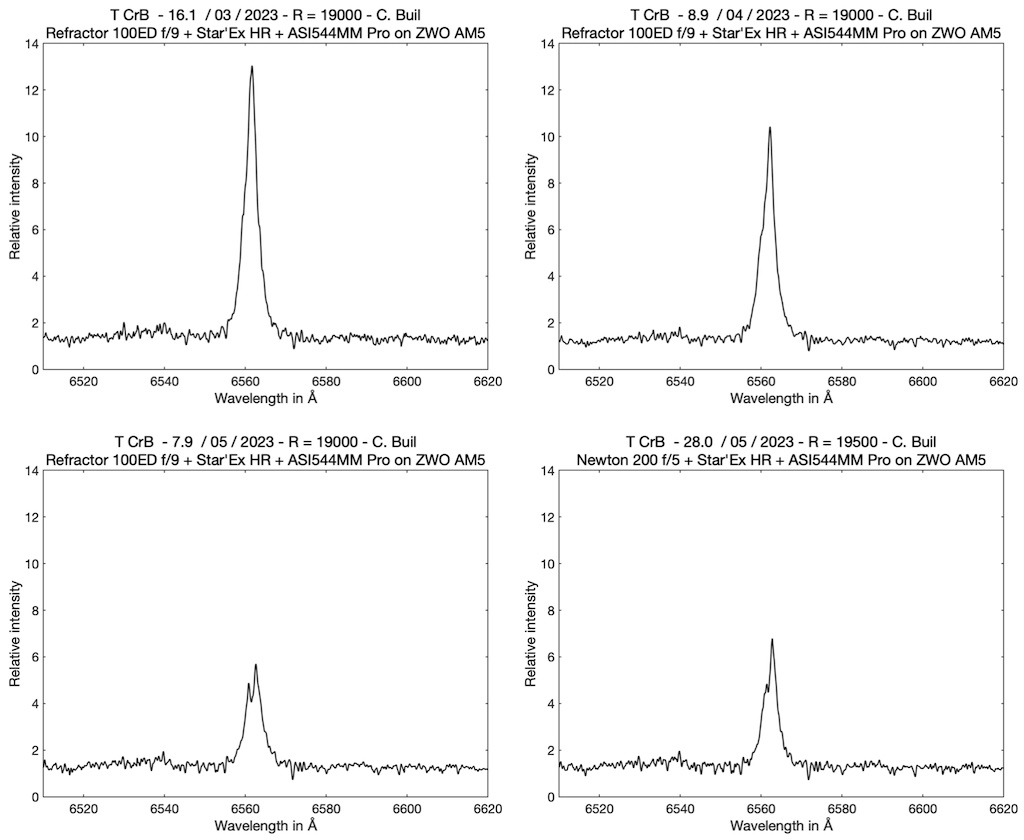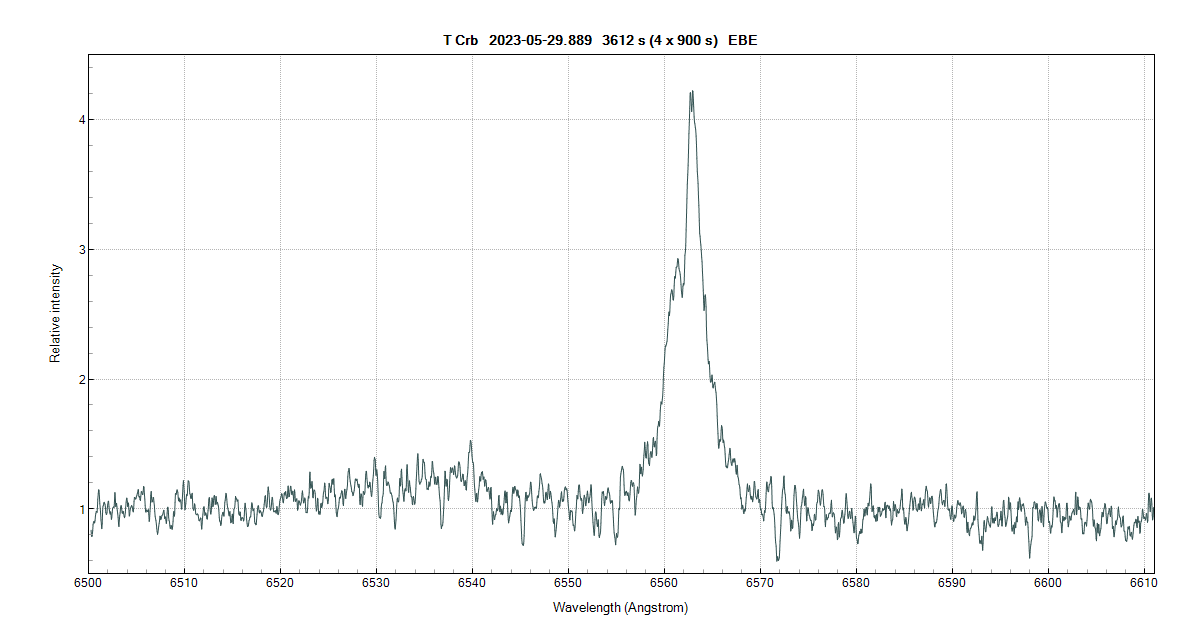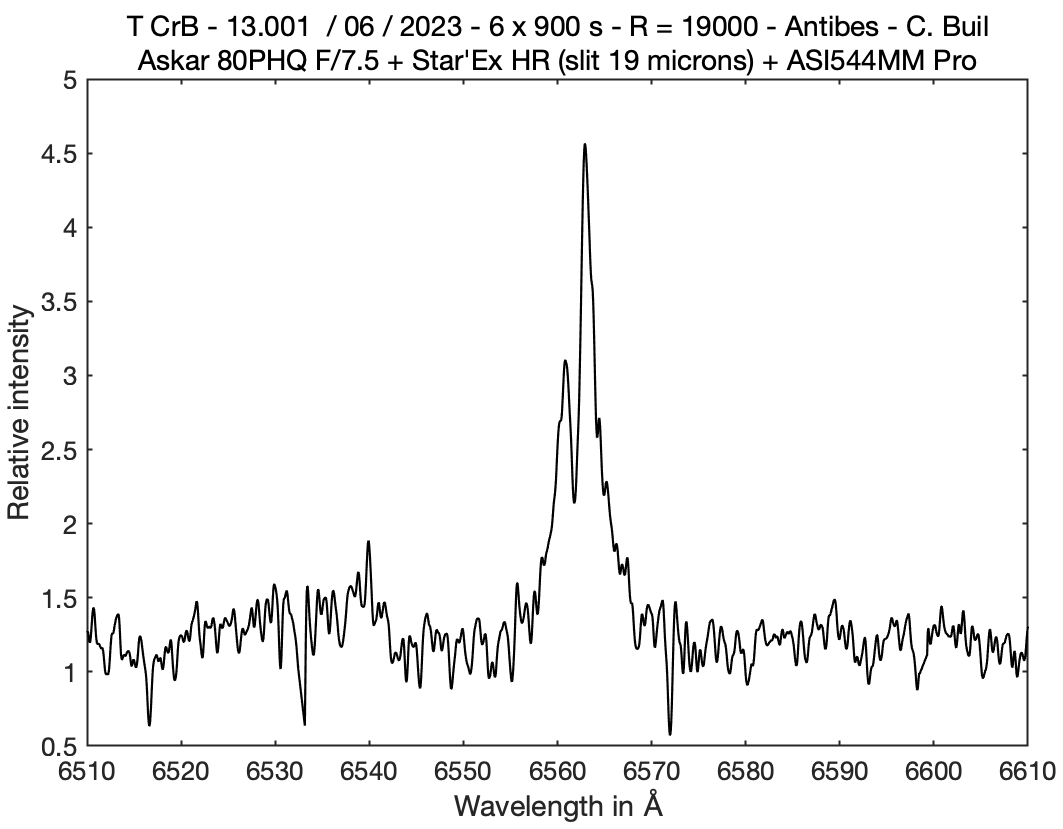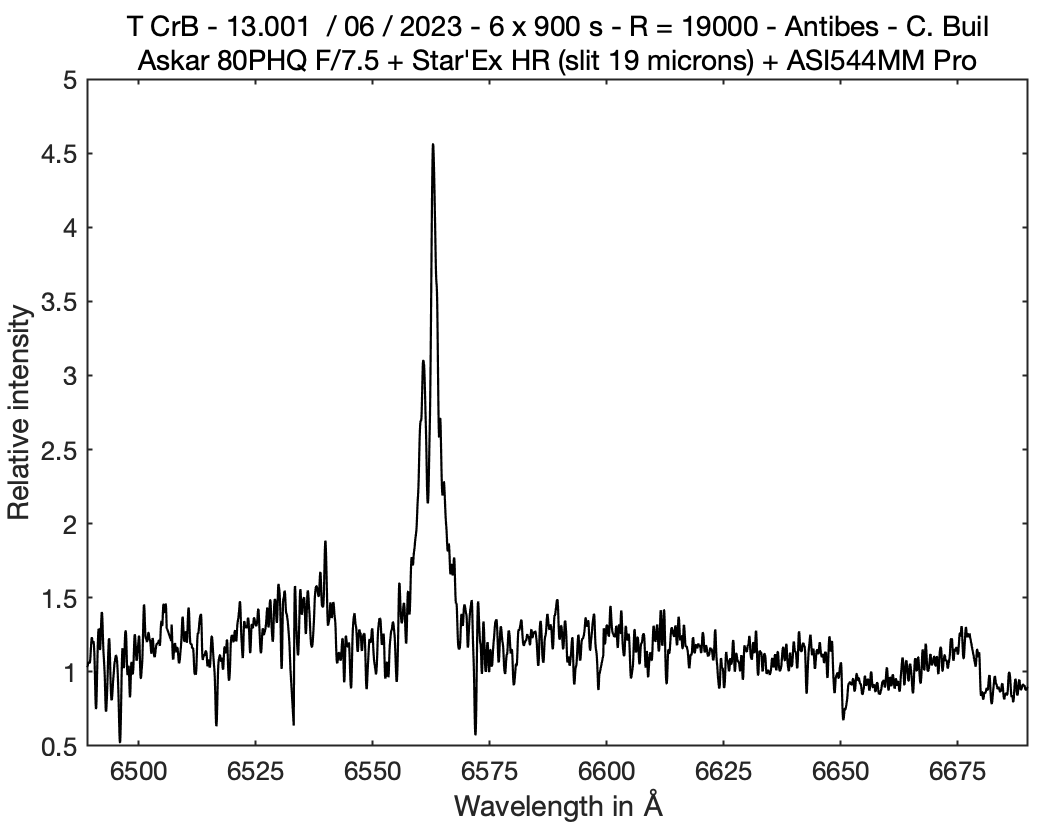Page 2 of 3
Re: T CrB before its new nova event
Posted: Mon Mar 28, 2022 7:53 pm
by Matthieu Le Lain
Hi all,
Here is a new spectrum of T CrB with an alpy on C8 (24/03/2022)

- T CrB - 24/03/2022
Matthieu
Re: T CrB before its new nova event
Posted: Sun Apr 10, 2022 6:35 pm
by Joan Guarro Flo
Hello,
That's T CrB from the SMM remote Observatory this last night.
Regards, J. Guarro.
Re: T CrB before its new nova event
Posted: Mon May 01, 2023 7:43 pm
by Francois Teyssier
Good!
The campaign is restarted after the (too long) seasonal gap
The last spectra show a fast decline of He II line toward 0 in low resolution spectra and very faint in echelle spectra.
This sudden fading after a long decrease could be a clue of the entrance of the system in the last phase before the nova outburst.
A page summarize the current status and the monitoring. It will be updated weekly.
http://www.astronomie-amateur.fr/Erupti ... TCrB0.html
A cadency of 2/3 spectra a week is suggested.
The behavior of the recurrent nova *before* the outburst may provide informations at least as important tahn the nova event in itself.
All the best and thanks in advance for your involvment.
fmt
Re: T CrB before its new nova event
Posted: Tue May 02, 2023 6:19 pm
by Francois Teyssier
Detection of strong flickering by M. Minev, R. Zamanov, K. Stoyanov (Institute of Astronomy and NAO, Bulgarian Academy of Sciences)
https://www.astronomerstelegram.org/?read=16023
The flickering increased compared to the last published values (my work)
stronomerstelegram.org/?read=15916
and graph:
http://www.astronomie-amateur.fr/DUAO/T ... ering.html
M. Minev+ conclude by the question:
Does it mean that the super-active state is over?
The increase of the flickering coincides with the sudden fading of He II.
http://www.astronomie-amateur.fr/Erupti ... TCrB0.html updated
Re: T CrB before its new nova event
Posted: Mon May 29, 2023 10:35 am
by Christian Buil
Alpha evolution at high spectral resolution (instruments from 4 to 8 inch + Star'Ex HR, on ZWO AM5 mount) :

C. Buil
Re: T CrB before its new nova event
Posted: Sat Jun 03, 2023 1:57 pm
by etienne bertrand
Un spectre de T Crb au LhiresIII

Re: T CrB before its new nova event
Posted: Sun Jun 04, 2023 6:29 pm
by Joan Guarro Flo
Hi there,
This is a T CrB graphics from the SMM Remote Observatory in this bad weather season.
Cheers, J. Guarro
Re: T CrB before its new nova event
Posted: Tue Jun 06, 2023 10:26 pm
by Guillaume Bertrand
Here's a new spectrum of T CrB with my little 72mm refractor. (A bit of a challenge

) In red, for comparison, a spectrum from a year ago.
Cheers,
Guillaume
Re: T CrB before its new nova event
Posted: Tue Jun 13, 2023 11:14 am
by Christian Buil
A high-resolution Star'Ex spectrum (R=19 000) made on June 13th from Antibes and like Guillaume B, using a small diameter, here an 80 mm Askar scope (model PHQ), all on an AM5 mount, and managed via ASIAir (except for the spectra storagel under Prism):

Full observed range :

The intensity of the Halpha line is still falling, while the star remains blocked at magnitude V=10. How far will this Halpha line go...
Christian Buil
Re: T CrB before its new nova event
Posted: Fri Jun 16, 2023 4:05 pm
by Francois Teyssier
Yes, the spectrum returns to the pre-high state aspect: the continuum is dominated by the M4 III red giant. The emission lines becomes fainter (even if He II and He I are still present)
During the two last months, the EW grew a little bit according to orbital phase. But the global trend is decline.
First low res spectrum in the database, more than 10 years ago.

- asdb_tcrb_20130217_146.png (52.02 KiB) Viewed 2409 times
Guillaume's comparison shows the decline observed during the last months.
But a word a caution: the flux and profiles of the lines are strongly dependent of the orbital phase. Thus the most accurate comparison should use spectra acquired at the same orbital phase
This is a key point of the symbiotic stars monitoring: long term and high cadency observations can produce very valuable results
It needs much more abnegation than short observing campaigns.
This is my conception of the contribution of amateurs to the community (in fact exactly the same state of mind as in photometry since one and half century)
And it is very appreciated by number of professionnal teams working on eruptive stars.
Our T CrB dataset (more than 760 spectra in 10 years) is a treasure for the research (even if it raises more news question than it solves !)
I'm working on a presentation for the SAS 2013 symposium. It will be ready next week.
Bonne continuation! Keep on the very good job!
François



